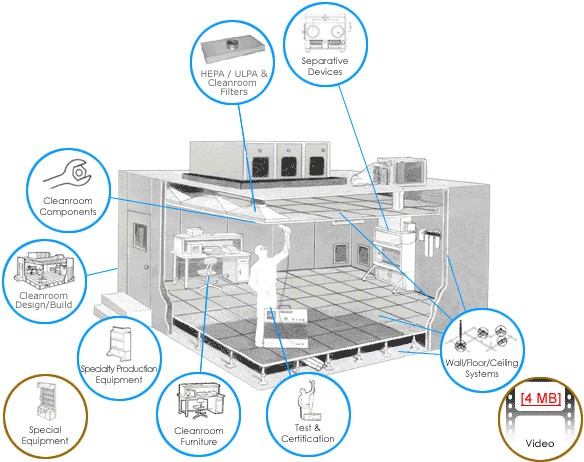
A clean space in which the quantity of floating dust (fine particles) and bacteria in the air is controlled. Moreover, air velocity, pressure, temperature, humidity, vibration and other factors affecting the work environment must be strictly controlled.
1. What is meant by cleanliness in the cleanroom?
Cleanliness can refer to residual particulate matter, limits for ionic and organic residues, fibers, anti-static characteristics and microbiological contamination.
2. What are the different class levels of Cleanrooms according to English (US Customary) Units?
(Remember, the lower the number, the cleaner the room. See Cleanroom descriptions #7.*)
Metric
Class
|
English
Class
|
0.1
MICRONS
|
0.2
MICRONS
|
0.3
MICRONS
|
0.5
MICRONS
|
M1.5
|
1
|
35
|
7.5
|
3
|
1
|
M2.5
|
10
|
350
|
75
|
30
|
10
|
M3.5
|
100
|
-
|
750
|
300
|
100
|
M4.5
|
1,000
|
-
|
-
|
-
|
1,000
|
M5.5
|
10,000
|
-
|
-
|
-
|
10,000
|
M6.5
|
100,000
|
-
|
-
|
-
|
100,000
|
Cleanrooms are classified by the amount of a particular size of particles in a cubic foot of air. Quantities may vary according to a product’s cleanliness requirement.
Example of how to read chart:
If we look at a Class 10 Cleanroom, no more than 350 particles of 0.1 microns in size, 75 of 0.2 microns in size, 30 of 0.3 microns in size and 10 of 0.5 microns in size are allowed in a cubic foot of air. No particles 5 microns in size are permitted in a Class 10 Cleanroom.
In a Class 100,000 there are no limits for particles 0.1, 0.2, and 0.3 microns in size but the room cannot have more than 100,000 0.5 microns in size and 700 particles 5 microns in a cubic foot of air.
NOTE: Measuring in English (US Customary Units), the amount of 0.5 micron particles in a particular cleanroom is how we identify it’s class of cleanliness.
3. What is the definition of the word micron?
A unit of length equal to 1 millionth of a meter or .000039th (39 millionth) of an inch. Another name for micron is micrometer.
4. What is meant by the English (US Customary) unit of measurement?
This is the English system of weights and measurements. In this form of measurement, we measure cleanliness in a room by a cubic foot of air.
5. Why does the S I unit of measurement of cubic meters allow more particles per unit space than the US Customary unit measurement of cubic foot?
One cubic meter is equal to 45.31 cubic feet (1m3=35.31ft3). Therefore, a cubic meter of space used to measure airborne particles is larger than the one cubic foot of space we use in the U S Customary units.
CLEANROOM DESCRIPTIONS:
*CLASS 1 CLEANROOM
A Cleanroom where particle count is not to exceed a total of 1 particle per cubic foot of air of a size 0.5 microns and larger and zero particles of 5.0 microns and larger.
*CLASS 10 CLEANROOM
A Cleanroom where particle count is not to exceed a total of 10 particles per cubic foot of air of a size 0.5 microns and larger, and zero particles of 5.0 microns and larger.
*CLASS 100 CLEANROOM
A Cleanroom where there are no more than 100 particles 0.5 microns and larger per cubic foot, and zero particles of 5.0 microns and larger.
*CLASS 1000 CLEANROOM
A Cleanroom where there are no more than 1000 particles per cubic foot of air 0.5 microns and larger, and no more than 7 particles 5.0 microns and larger.
*CLASS 10,000 CLEANROOM
A Cleanroom where there are no more than 10,000 particles per cubic foot of air 0.5 microns and larger, and no more than 70 particles 5.0 microns and larger.
*CLASS 100,000 CLEANROOM
A Cleanroom where there are no more than 100,000 particles per cubic foot of air 0.5 microns and larger, and no more than 700 particles 5.0 microns and larger.
6. How small a particle does the human eye see?
The naked eye can see particles as small as 40-150 microns.
7. People are the largest contributor of airborne particles in a Cleanroom. How many skin flakes do they shed?
People shed 1 billion skin flakes per day.
8. In one minute, how many 0.3 micron particles does a person shed?
Activity
|
Particles Per Minute
|
Person sitting or standing
|
100,000
|
Moving arm
|
500,000
|
Walking slowly
|
5,000,000
|
Walking at an average pace
|
7,500,000
|
Walking quickly
|
10,000,000
|
Besides people, what are some contaminants in a Cleanroom?
Raw Materials
Chemical and Gases
Machinery and Equipment

 Home
Home
 About Us
About Us
 Product List
Product List
 Clean Foam Swab
Clean Foam Swab
 Clean Polyester Swab
Clean Polyester Swab
 Cotton Swab
Cotton Swab
 Cleanroom Wipe
Cleanroom Wipe
 Cleanroom & ESD Fabric
Cleanroom & ESD Fabric
 Cleanroom & ESD Garment
Cleanroom & ESD Garment
 Clean & ESD Footwear
Clean & ESD Footwear
 Clean & ESD Glove/Finger Cot
Clean & ESD Glove/Finger Cot
 Cleanroom Stationery
Cleanroom Stationery
 ESD Mat
ESD Mat
 ESD Packaging & Storage
ESD Packaging & Storage
 ESD Chair
ESD Chair
 SMT Magazine Rack
SMT Magazine Rack
 ESD Tweezer
ESD Tweezer
 ESD Tool
ESD Tool
 ESD Tester
ESD Tester
 ESD Instrument
ESD Instrument
 Others
Others
 Technical Support
Technical Support
 Contact Us
Contact Us